Every week, on “Round the World Wednesday” we share tips for planning, budgeting and selecting a route, plus advice on where to go and what to see and do all around the world.
Want help planning your RTW trip? Sign up for Plan Your RTW Trip in 30 Days – it’s FREE!
If you’re an avid scuba diver who just can’t stay out of the water for too long, consider making diving a major theme of your RTW trip. Not only will you get to indulge your love for underwater exploration regularly throughout your travels, it could take you to some unusual places you might not necessarily have thought to visit on your own.
We’ve picked out three countries around the world and feature some of their dive highlights that you can fit into your RTW itinerary.
Indonesia
We recommend starting off your RTW diving adventure in Indonesia – with its wide variety of dive sites, teeming biodiversity, and clear warm waters, you could spend a year diving the entire country and always find something new. The seasoned diving scene, weak currency, and good diving conditions all year round make Indonesia an ideal place for both budget and luxe trips, and there’s something for everyone whether you’re a newbie or experienced. It’s fairly easy to get to most of these places with Indonesia’s extensive domestic transport system of airplane and ferry.
[social]
Getting there and around:
Most international flights to Indonesia transit via Singapore’s Changi Airport or via Jakarta, For citizens from most countries, you can get your tourist visa-on-arrival at several fixed entry points within Indonesia that lasts 30 days and will allow you to travel throughout the country. For a full list, check out the official Indonesia tourism website here.
Within the country, Indonesia is an archipelago with over 17,000 islands – getting from island to island is usually a matter of hopping on one of many domestic flights or navigating the extensive ferry system. Unfortunately the safety record of both local airlines and ferry services is not the most stellar. Some of these locations are a little remote, so we recommend making your accommodation bookings online and arranging for a pick-up from the airport. Your dive company or resort will then take care of getting you to your dive sites, usually via private car or boat.
Key Dive Sites:
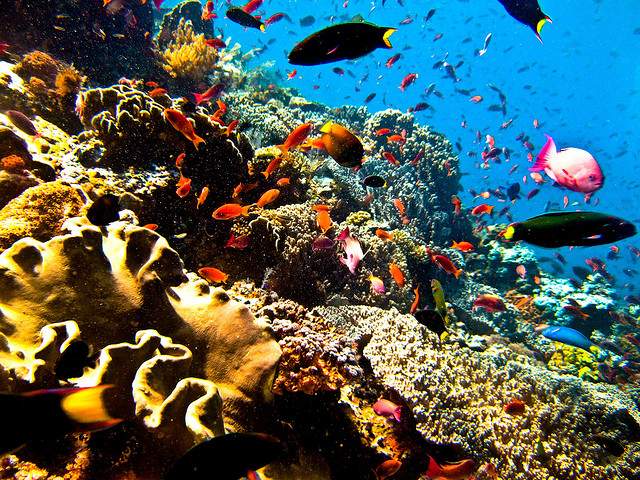
Scuba Diving is one of Indonesia’s key tourism activities, so it’s easy to find reputable dive companies or resorts in these areas. One is spoilt for choice by the sheer variety of diving offered across the country – you could spend a few months making your way across the islands and see something new every day. Not all are mentioned here, but we’ve listed a few of the best ones to get you started:
Sulawesi (Manado, Sam Ratulangi Airport)
A good place to start off is Manado in North Sulawesi, gateway to the famous Bunaken Marine Park and where besides the wide variety of tropical fish and coral, you just may discover a Coelancanth, the rare living fossil fish. It’s also an hour’s drive away from the Lembeh Straits, known for its muck diving and odd tiny creatures hidden in its black sand that are every underwater photographer’s dream. You can take a day trip or a live-on-board out to Sangihe Islands, which is close to Mahengetang, the only underwater volcano you can dive, complete with bubbling waters and sulphur-covered rocks.
Bali (Denpasar, Ngurah Rai Airport)
Bali is renowned for its surfing, beaches, and nightlife down south, but also has good diving if you venture out of the touristy areas. The dive sites are mostly located on the eastern side of the island, with popular ones being Tulamben in the northeast coast, with its USS Liberty Wreck, while Nusa Penida and the surrounding cluster of islands in the south are known for frequent sightings of the giant Mola Mola (Ocean Sunfish).
Papua (Sorong, Domine Edward Osok Airport)
The crowning glory of dive sites in this region is Raja Ampat, where over 75% of all known fish and coral can be found. It is still a relatively pristine dive site due to its limited accessibility and high prices – you need a special permit to dive in this area. The best way to get around the remote dive sites is to book a live-on-board trip (LOB) and sail around the islands. Sorong is the gateway to Raja Ampat, and the only way to get there is via domestic flights, with the mostly popular being via Jakarta or Manado.
Alternatives:
If Indonesia’s not your thing, consider the Philippines, another island archipelago nearby. It was a hard fight deciding which Asian country was our pick, but we felt Indonesia had just a little more variety to offer overall. Thailand and the Similan islands are also popular, and Asia is also home to another top dive site, the famous Sipadan in Borneo, East Malaysia. If you love warm water diving, Southeast Asia is the perfect place to be, as it’s cheaper to dive and get around than the Americas and Europe.
For more on travel to Indonesia, check out the following articles and resources:
- Read Exploring Indonesia by Motorbike
- Read How to Travel Like a Local in Indonesia
- Catch a flight to Bali
- Find a hostel in Indonesia
Galapagos Islands, Ecuador
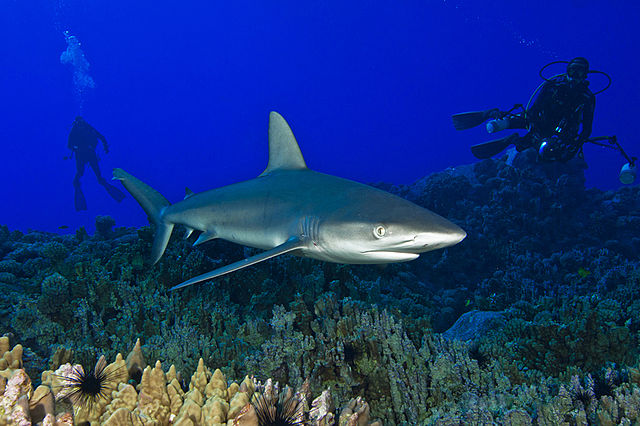
One diving spot you have to attempt at some point in your life (and what better time than on your RTW trip) are the Galapagos Islands off the coast of Ecuador. Charles Darwin learned a lot from exploring these isolated island,s and you could too, though it may cost you a pretty penny to do so. Also, save this spot for a later point in your trip when you’ve picked up more diving experience, as the colder and choppier waters are best suited for more seasoned divers compared to that of the warmer tropical waters. Daunting as it may seem, the prospect of being able to dive with schools of dolphins, sharks, sea lions, seabirds, marine iguanas, and even the odd whale makes for a pretty incredible experience.
Getting there and around
The Galapagos are a group of islands over 900 km from the western coast of Ecuador. International flights mostly hail from South American countries but also include USA, Amsterdam, and Madrid – they land either in the Quito International Airport or Guayaquil. From either of these airports, you take Aerogal or TAME airlines to the Galapagos Islands, landing at either Baltra or on San Cristobal. Flights tend to leave in the morning, so buffer in an overnight transit as most international flights don’t come in so early. July, August, and December are considered the high seasons, and a round-trip ticket costs around $450-$500 on average. More details here.
The best way to get around the islands and reach the best dive spots will be via LOB, and these tend to be on quite nice boats, which means pricey. You can also combine diving with land tours and have your tour operator put together a nice package so you can pace your dives. Land based diving is cheaper, but you can’t reach some of the more spectacular sites listed below as they are too far for a day trip. Another option is where you remain land based but hop to different islands to dive at their various sites, though that’s cheaper than an LOB, you need to have a lot more flexibility and time. Consider both options if you are there for a long period and want to cover everything – some sites are restricted to land-based while others are only for LOB.
Key dive sites:
Note that there is a $100 entry fee to visit the islands. Also because it’s a protected area, no night diving is allowed. Two main seasons exist here, each with their own pros and cons, so pick what you really want to see and time your journey right.
– Warm/Wet season (December to May) has calmer waters and better weather all around. Visibility is a little lower, and you have an abundance of manta rays and hammerhead sharks.
– Cold/Dry season (June to November) means you’ll need thicker wetsuits and more gear to keep you warm, like hoods as temperatures range around the low 20s and even down to 16 degrees, and the currents will be more challenging. But why would you want to put yourself through that when you can dive during the warm/wet season? Two words: WHALE SHARKS.
Wolf Island and Darwin Island [LOB only]
Wolf Island is actually an extinct volcano that extends 250m above the waves, while Darwin Island is 40km away from it. The only way to reach these spots is by LOB, as it is too far from the main Galapagos Islands for a day trip, and there are no land visits to the islands. Large pelagic creatures are in abundance here, whether it be swarming schools of jacks and tuna, or hundreds of hammerhead sharks at the cleaning stations. Other common sightings include sea lions, eagle rays, and of course the odd whale shark. This is an advanced spot – be prepared for strong currents and cold waters.
Santa Cruz (Land based)
Santa Cruz is home to Puerto Ayora, the most populated town in the Galapagos. It’s central location amidst the island cluster means access to a large number of dive sites. Academy Bay has a number of sites suitable for beginners, and for those land-based divers who won’t be visiting Wolf and Darwin Islands, sites here renowned for hammerhead and other pelagic sightings include Gordon Rocks, North Seymour, and Mosquera Islet. Non-diving wise, it is the only island with six different vegetation zones, and you can visit the Charles Darwin Research Station and Black Turtle Cove, a mangrove estuary in your down time.
Isabela (Land Based/LOB)
This is the largest island in the Galapagos region, shaped like a seahorse and formed by six volcanoes, five of which are still active, making it one of the most volcanically active places on earth. Los Tuneles, with its maze of lava tubes due to recent lava flows from the volcanoes, makes this an unusual dive site; however, waves can be strong here during the latter part of the year. Cape Marshall and Puente Vincente Roca are also popular dive sites, though only accessible via LOB due to their distance from land. After diving, one can hike the Sierra Negra volcano or check out the Wall of Tears, a memorial site to prisoners who were once confined to this island.
Alternatives:
If the cost and diving level required for Galapagos is prohibitive (though the reviews all say it’s worth it), there are lots of other options in the nearby region that make excellent alternatives for much cheaper. Utila in Honduras with its whale shark sightings and Belize with its famous Blue Hole are some of the more popular spots.
Read Finally, A Galapagos Trip You Can Afford to find out how you can travel the Galapagos on the budget.
Iceland
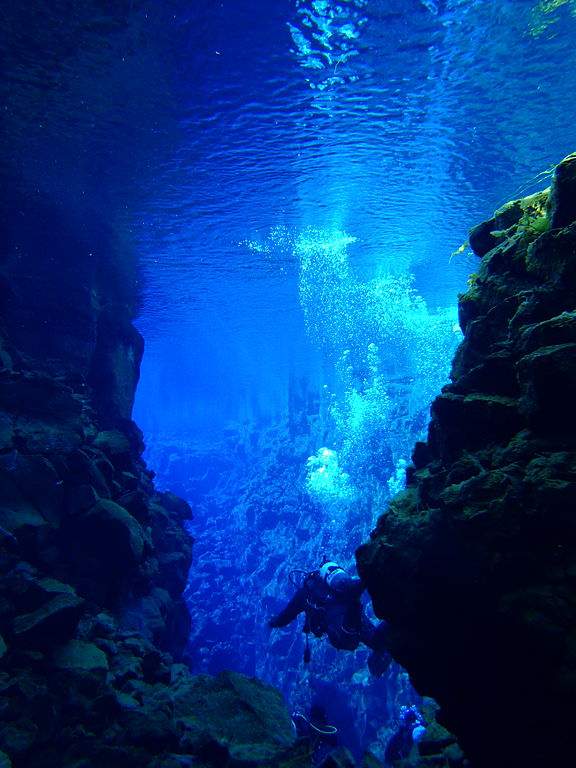
For something completely different from your usual tropical water diving, one place worth checking out is Iceland. It’s not the first place that pops into your head when you think about diving, and you’ll need to be certified in dry suit diving when you’re there because of the cold, cold water, but it offers up waters with amazing clarity and unusual cold water creatures to look at. Be warned though, Iceland can be expensive to visit, so save those pennies wisely.
Getting there and around
The main airport is Keflavik International airport, with direct flights mostly coming from European countries, with Icelandair and Delta Airlines offering a handful of flights from the USA. The flights tend to be seasonal though, with most operating during the summer months – Icelandair is the only one that operates during winter. Due to low competition, the cost of flying to Iceland may be more expensive, though Iceland’s newly launched low-cost airline WOW air offers a budget option from many major European cities. If you’re adding Iceland to your RTW trip, Icelandair does offer a free stopover on the way to many European destinations, so this is something to look into.
Iceland itself is not very big, and driving is the easiest way to get around, though be prepared for icy conditions in the colder months. If not, bus is an option, as there are no trains on Iceland.
Key Dive Sites
Iceland’s dive sites are all cold water dives with temperatures ranging around the single digits, and they require a dry suit. You can get certified in a dry suit, though it is better to rack up some experience first for some of the more challenging sites,.
Silfra (Thingvellir National Park)
This unique dive site an hour away from the capital of Reyjkjavik is situated in a crack between the Eurasian and American continental plates. The water here is a constant 2-4 degrees celsius and come from the glaciers, so pure and fresh that you could drink it while diving. While you’re unlikely to see many fish in here, you’ll be mesmerized by the 100m+ visibility and the intensely bright colors of the water. There are 3 dive sites here – Silfra Hall, Silfra Cathedral and Silfra Lagoon – all suitable for beginners and new dry suit divers as it is a sheltered cove with only a mild current. In addition this site is diveable all year round.
Strytan (Eyjafjord, Akureyi)
The only geothermal cone in the world that you can dive to, Strytan is a 50m tall limestone structure with its highest point 15m below the sea level (most other geothermal cones are found at 3000m deep). Also known as a thermal chimney, it pumps out 70+ degrees celcius hot water from the hot springs below the sea bed. You can feel the warm water as you dive by. You will find large schools of cod here and other life on the cone itself. This dive site requires more advanced skill as the currents are stronger and good buoyancy is needed.
Grimsey Island
This island off the coast of Iceland is its northernmost point and lies on the Arctic Circle. It is worth visiting because of its huge bird population of puffins, arctic terns, and other birds living on the island, that you might be lucky enough to dive with. The birds vastly outnumber the human population (around 100 residents only) and you can get there via domestic flight from Reykjavik via Air Iceland, or take a 3-hour ferry from Akureyri that runs three times a week. Recommended for summer period as the seas are too rough in winter.
Alternatives
Malta is one of the better spots to dive in the Mediterranean region with warmer water and abundant sea life. Croatia and its crystal blue waters of the Adriatic sea are home to numerous wrecks worth checking out as well. If you’re a fan of dry suit and cold water diving, consider the Irish sea and the Isle of Man.
Check out the following articles and resources about traveling in Iceland:
- Catch a flight to Iceland
- Book a hostel in Iceland
- Read 9 Incredible Things to Experience in Iceland
- Read Adventures in the Dark: Nighttime Activities Around the World
Other notable mentions
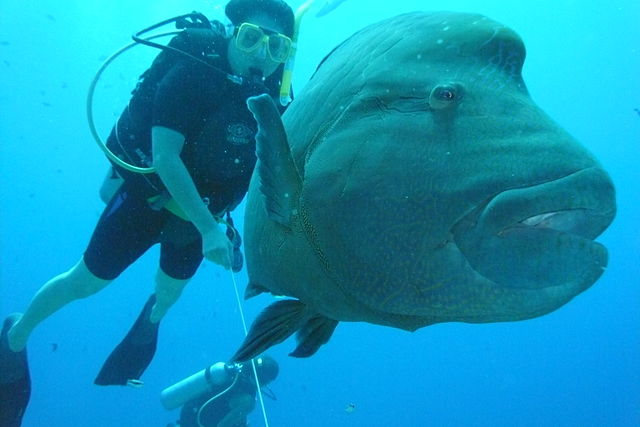
This is far from an exhaustive list – there are so many countries and dive sites that you can choose to visit, we would run out of breath trying to list them all. Here are other notable sites that we think you should check out if you have the chance to:
Palau:
Dive at its famous Blue Corner known for huge shoals of large fish and other pelagics, and snorkel (no diving allowed) at the Jellyfish Lake, a lake filled with millions of golden jellyfish that have lost their stingers over the years.
Mexico:
Home to the bizarre Cancun Underwater Museum, where over 400 clay sculptures have been placed on the seabed to create an artificial reef. Sistema Dos Ojos, one of the world’s largest underwater cave complexes, is also worth checking out for specialist cave divers.
Austria:
This landlocked country might be an odd place to think about diving, but it’s home to Gruner See, a park that transforms into a lake every summer when the surrounding glaciers melt and flood the park.
Egypt:
The Middle East region is not all deserts and sand, but home to the Red Sea and Arabian Sea as well, both popular areas for diving. The SS Thistlegorm wreck is one of the best wreck dives, as well as the nearby Sharm Al Sheikh area.
Now that you have decided on where you want to go, here are some other considerations:
Certification
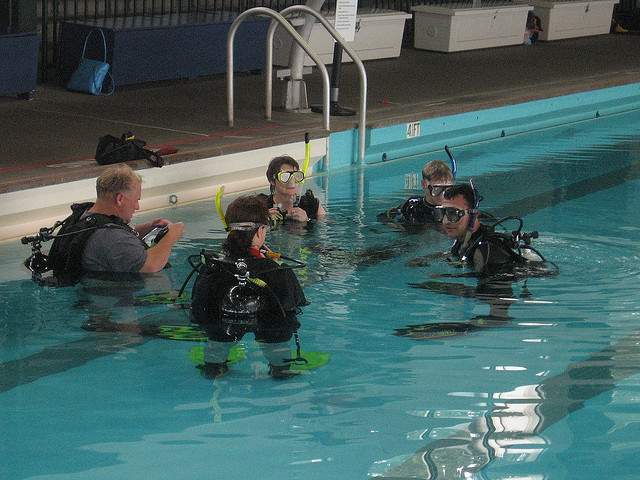
(PADI‘s levels of certification are used for reference here as they’re one of the most prevalent certifiers worldwide. Most certifiers have roughly equivalent levels of certification.)
The very basic level you will need to dive is Open Water/Basic Level certification. Certification involves theory lessons, confined pool sessions to test skills, as well as a few practical sessions in the open sea, which takes a week on average if you pace yourself.
For a diving RTW trip, we advise having at least an Advanced Level certification, which allows you to go deeper (30m instead of 18m) and equips you with more skills like navigation and better buoyancy control. You can also take specialized certifications, like night diving and wreck diving that allow you to visit some of the more unusual sites. If you are not already a frequent diver who has clocked a good number of dives, it is best to start your trip with the simpler dive sites with less challenging conditions and gain experience before attempting the more challenging ones.
Gear

Most reputable dive centers have gear that you can rent at an additional cost, so you do not have to carry heavy gear around with you. Maintenance of your gear is another issue, which can be tough to do on the road and cost a pretty penny. Items like the Buoyancy Control Device (BCD), regulator and fins are the main reasons for bulk and cost. If you plan to move around a lot and do more non-diving travelling, we would not recommend lugging these around with you unless you are of a really odd size and need specifically customized gear to dive. On a side note, airlines that frequent dive destinations sometimes waive excess baggage costs if you are carrying scuba diving gear, so do check beforehand.
For essentials, stick with the smaller items which are necessary for safety that you should be familiar with. A dive computer doubles as a watch and a log of all your dives, so a good reliable one is indispensable. It has to be serviced regularly though. A good surface marker buoy (SMB) and torchlight that you are familiar with are easy to pack and good to have on hand when you dive for safety. You will probably want to have your own wetsuit and mask custom fitted for your comfort; both are compact enough not to take up too much space in your luggage.
When to dive
Different dive sites have different dive seasons based on the weather, that affects the visibility, types of animals, and water temperature, so take note of that when you’re planning your itinerary. On an average dive trip, you usually dive 2-5 dives in a day, depending on the dive conditions. If you’re going to spend most of your RTW diving, remember to pace yourself and stay hydrated – you do not have to do every dive, and it can be quite taxing on your body if you are not fit enough. Also if you’re traveling, don’t forget about the 24-hr no-fly rule in which you do not fly after a dive to ensure the nitrogen in your blood has time to clear – decompression sickness can be bad, and even fatal.
Insurance:
It may not be the cheapest thing, but if you’re going to do some intensive diving throughout your trip, consider investing in Diver Alert Network (DAN) insurance which is specially customized to divers needs. It covers things including use of Hyperbaric chambers in case of decompression sickness, things that most regular travel insurance exclude and can be really expensive.
To read more about scuba diving, check out the following articles:
Photo credits: Indonesia – , Galapagos – Tiburon, Iceland – Silfra, Certification – oregonkat, Gear – Thing Family, Weather – Chika, Palau – LuxTonnerre

